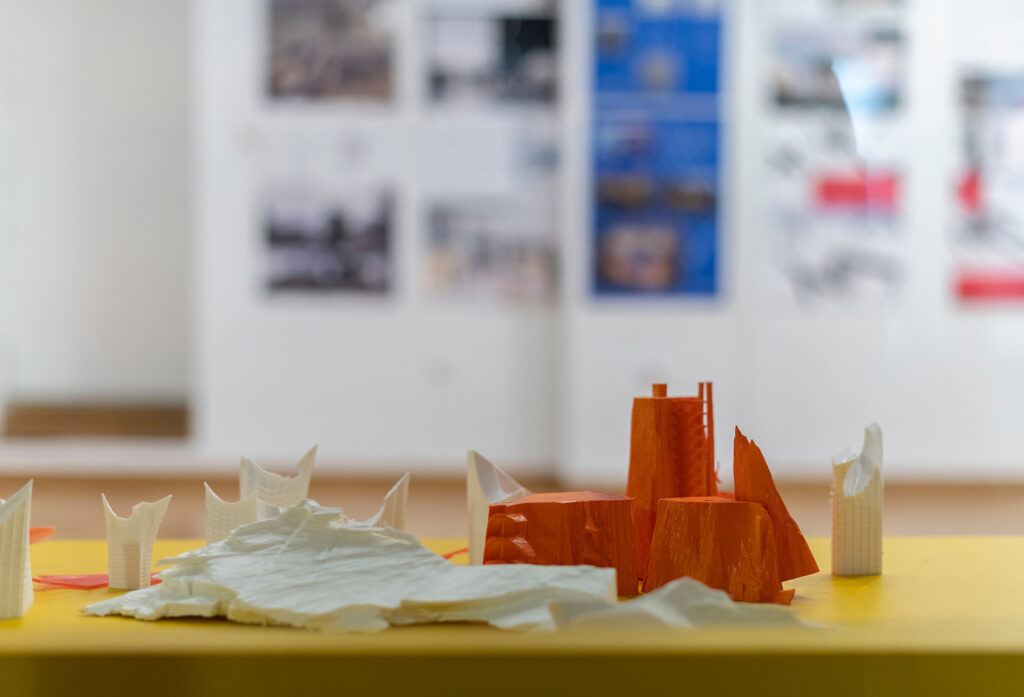The 2023 annual event ON ARCHITECTURE titled ‘Challenges in Design’ is hosted by the Serbian Academy of Sciences and Arts, Gallery of Science and Technology and Rectorate of the University of Belgrade in Serbia on 5-19 December 2023.
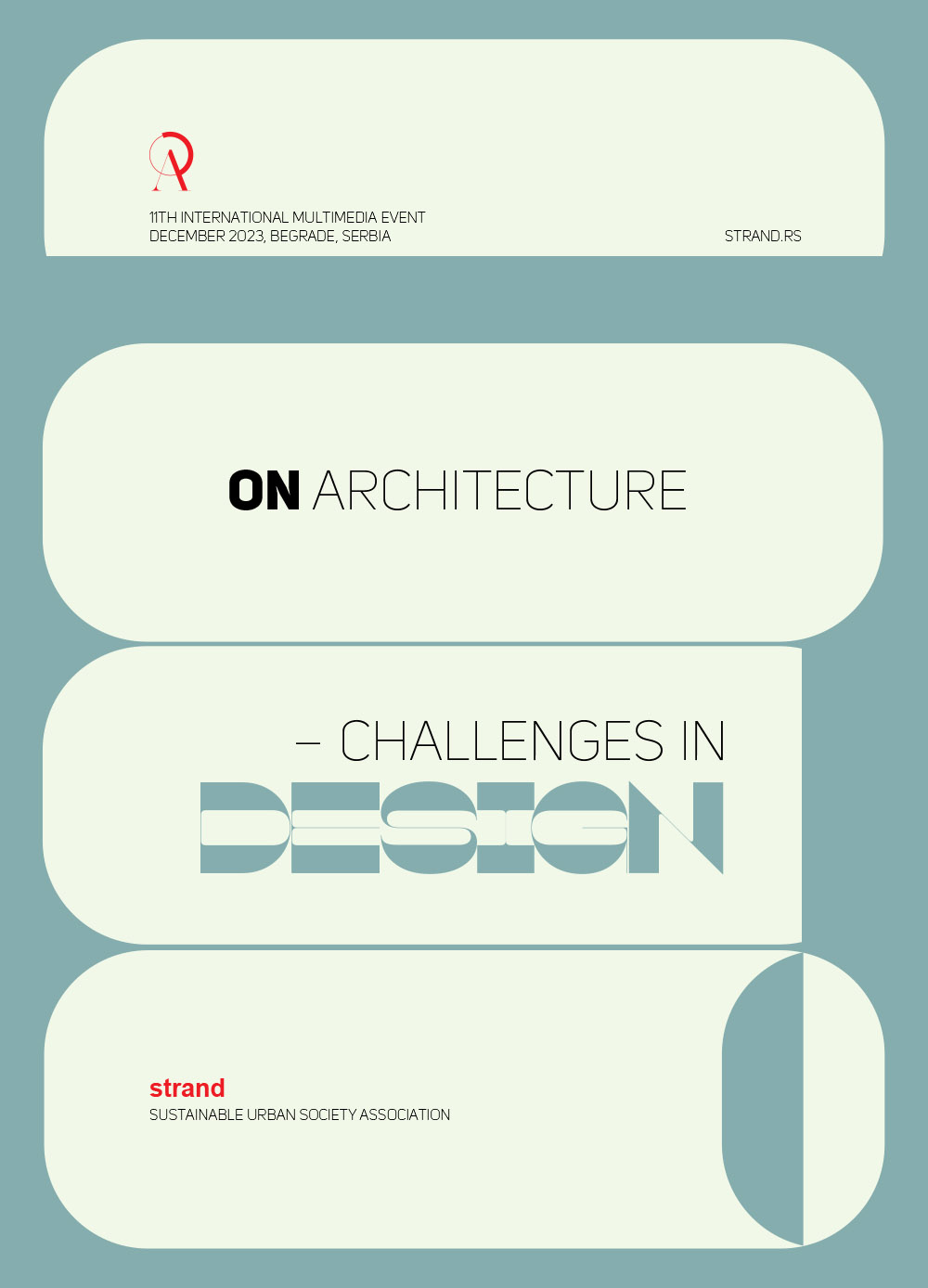
Call for contributions invites researchers and practitioners to submit proposals for presentations that relate to the conference and exhibition theme and enhance peer-learning.
DETAILS
When
— CONFERENCE
7-8 December 2023
— EXHIBITION
5-19 December 2023
Call FOR CONTRIBUTIONS
Call for Contributions is now closed.
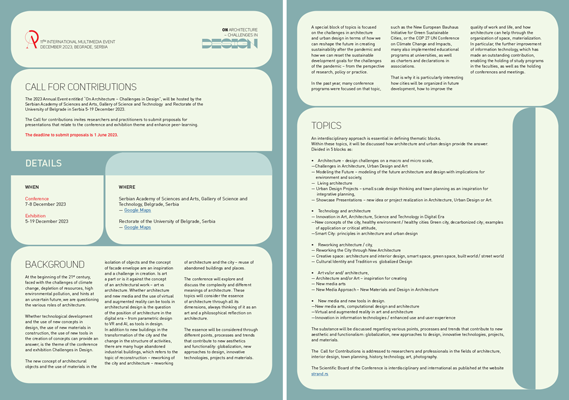
Selection Outcomes for the 2023 International Conference and Exhibition “On Architecture – Challenges in Design”.
Background
At the beginning of the 21st century, faced with the challenges of climate change, depletion of resources, high environmental pollution, and hints at an uncertain future, we are questioning the various roles of architecture.
Whether technological development and the use of new concepts in design, the use of new materials in construction, the use of new tools in the creation of concepts can provide an answer, is the theme of the conference and exhibition “Challenges in Design”.
The new concept of architectural objects and the use of materials in the isolation of objects and the concept of facade envelope are an inspiration and a challenge in creation. Is art a part or is it against the concept of an architectural work – art vs architecture. Whether architecture and new media and the use of virtual and augmented reality can be tools in architectural design is the question of the position of architecture in the digital era – from parametric design to VR and AI, as tools in design. In addition to new buildings in the transformation of the city and the change in the structure of activities, there are many huge abandoned industrial buildings, which refers to the topic of reconstruction – reworking of the city and architecture – reworking of architecture and the city – reuse of abandoned buildings and places.
The conference will explore and discuss the complexity and different meanings of architecture. These topics will consider the essence of architecture through all its dimensions, always thinking of it as an art and a philosophical reflection on architecture.
The essence will be considered through different points, processes and trends that contribute to new aesthetics and functionality: globalization, new approaches to design, innovative technologies, projects and materials.
A special block of topics is focused on the challenges in architecture and urban design in terms of how we can reshape the future in creating sustainability after the pandemic and how we can reset the sustainable development goals for the challenges of the pandemic – from the perspective of research, policy or practice.
In the past year, many conference programs were focused on that topic, such as the New European Bauhaus initiative for green sustainable cities, or the COP 27 UN conference on climate change and impacts, many also implemented educational programs at universities, as well as charters and declarations in associations.
That is why it is particularly interesting how cities will be organized in future development, how to improve the quality of work and life, and how architecture can help through the organization of space, materialization. In particular, the further improvement of information technology, which have made an outstanding contribution, enabling the holding of study programs in the faculties, as well as the holding of conferences and meetings.
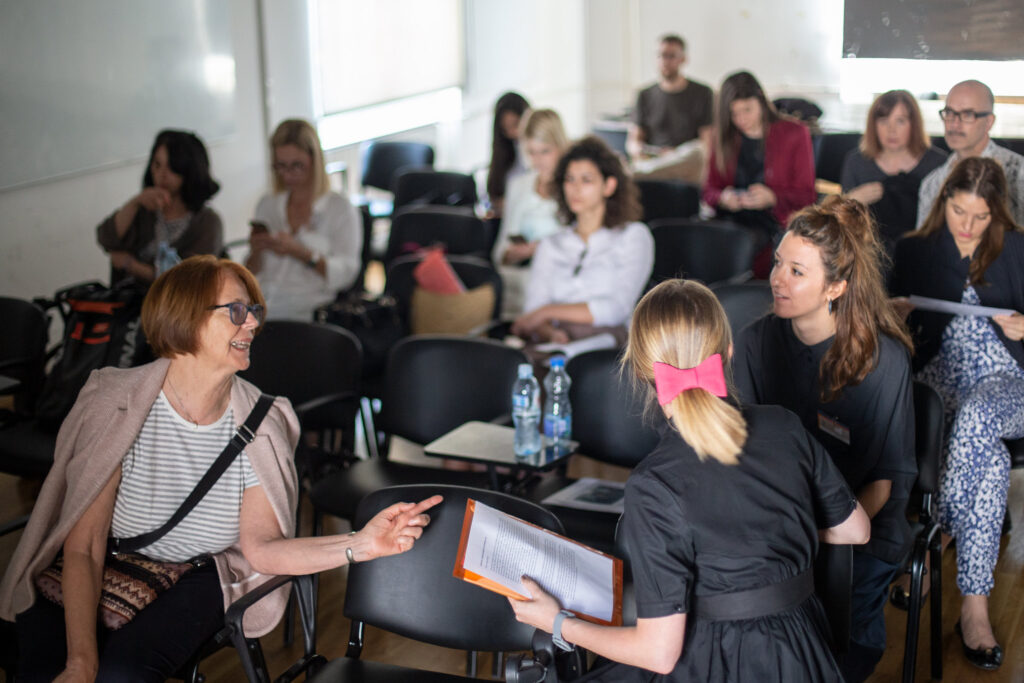
Topics
An interdisciplinary approach is essential in defining thematic blocks. Within these topics, it will be discussed how architecture and urban design provide the answer. Divided in 5 blocks as:
- Architecture – design challenges in macro and micro scale
—Challenges in Architecture, Urban Design and Art
— Modeling the Future – modeling of the future architecture and design with implications for environment and society,
— Living architecture
— Urban Design Projects – small scale design thinking and town planning as an inspiration for integrative planning,
— Showcase Presentations – new idea or project realization in Architecture, Urban Design or Art.
- Technology and architecture
— Innovation in Art, Architecture, Science and Technology in Digital Era
—New concepts of the city, healthy environment / healthy cities Green city, de-carbonized city; examples of application or critical attitude,
—Smart City: principles in architecture and urban design
- Reworking architecture/ city
— Reworking the City through New Architecture
— Creative space: architecture and interior design, smart space, green space, built world / street world
— Cultural Identity and Tradition vs globalized Design
- Art and architecture
— Architecture and/or Art – inspiration for creating
— New media arts
— New Media Approach – New Materials and Design in Architecture
- New media and new tools in design
—New media arts, computational design and architecture
—Virtual and augmented reality in art and architecture
—AI influence and innovation in information technologies / enhanced use and user experience
The substance will be discussed regarding various points, processes and trends that contribute to new aesthetic and functionalism: globalization, new approaches to design, innovative technologies, projects, and materials.
Call for contributions is addressed to researchers and professionals in the fields of architecture, interior design, town planning, history, technology, art, photography.
CONFERENCE & EXHIBITION Dates
CONFERENCE
1 March – 30 June 2023
Open Call
30 June 2023
Selection Outcome
30 June – 20 September 2023
Registration is open
July 2023
Book of Abstracts (E-Book)
20 September 2023
Paper Submission
(For Papers, length from 3500 up to 5000 words, maximum 50 references, the word count refers to the main body of text, excluding the title page, abstract, references etc.)
September 2023
Final Program
20 November 2023
Full Paper and Presentation Submission
7-8 December 2023
Conference
Mid-December 2023 after Conference Presentations
Conference Proceedings (E-Book)
EXHIBITION
1 March – 30 June 2023
Open Call
30 June 2023
Selection Outcome
30 June – 20 September 2023
Registration is open
20 September 2023
Poster Submission
(dimensions 60 x 80 cm as .pdf or .jpg files and 200 dpi resolution for Jury Evaluation)
November 2023
Exhibition Book (E-Book)
5 December 2023
Exhibition Book distribution at the Award Ceremony
Conference KEYNOTE SPEAKERS
International Conference Keynote Speakers – Vladan Djokić (Serbia), Francesco Carota (Mexico), Nikolas Patsavos (Greece), Christiane Wagner (Brazil), Milos Milovanovic (Canada), Marina Nenković-Riznić (Serbia), Eva Cetinić (Switzerland), Dejan Grba (Serbia), Jasna Jovićević (Serbia) and Carmelo Zapulla (Spain) with Conference Masterclass Presentation by professor Branislav Mitrović (Serbia).
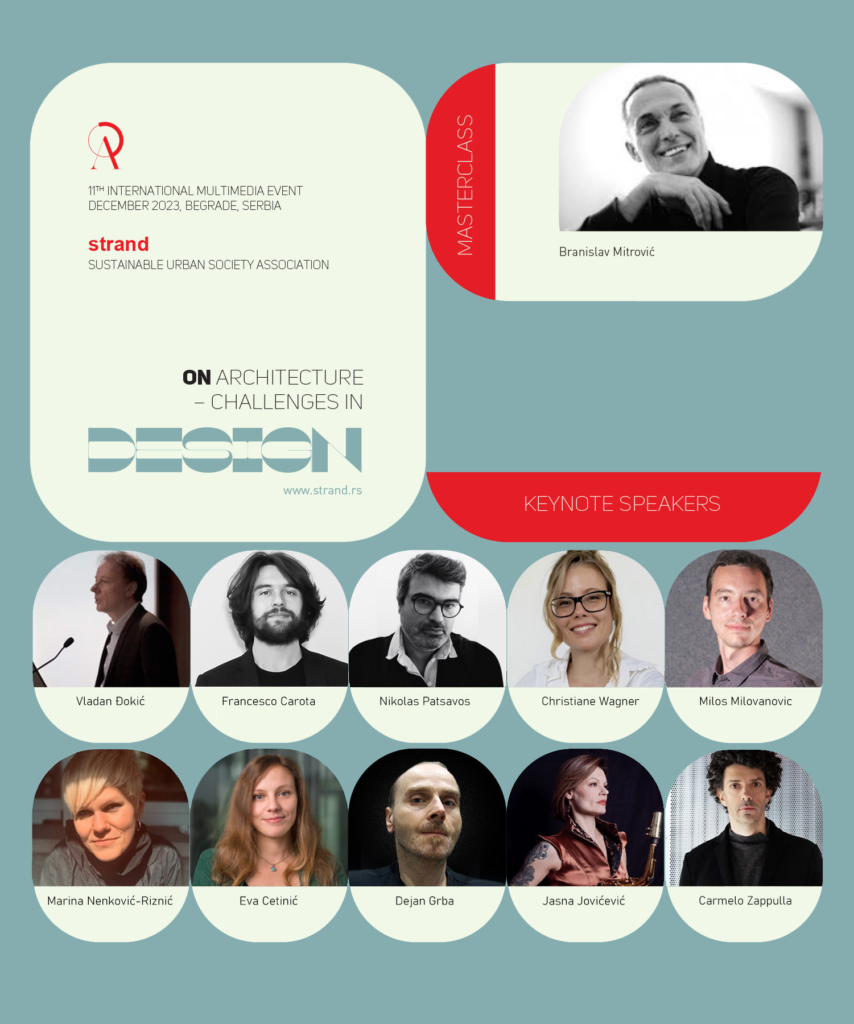
Konferencijsko masterklas predavanje* profesor Branislav Mitrović
Razvoj arhitektonskog jezika: od primarnih do apstraktne forme
Predavanje prikazuje evoluciju u arhitektonskom radu autora kroz formiranje odnosa prema prostoru, kontekstu, pa i tradiciji. U izlaganju se sa posebnom pažnjom tumači težište projektantskog procesa – istraživanje i razumevanje primarnih konstruktivnih geometrija i njihovo prevođenje u apstraktni oblik. Osvrtom na niz kuća i arhitektonskih tema iz različitih faza autor na primeru sopstvenih projekata komentariše razvoj tehnika i oblikovnih principa, polazeći od relacije funkcije i forme. Promene nastaju, između ostalog, pod uticajem ubrzanog napretka savremenih graditeljskih tehnologija, prepoznatog kao jedan od mogućih indikatora novog pravca mišljenja u arhitekturi obuhvatajući doživljaj naraslih mogućnosti kao i ideju o njihovom stalnom rastu.
Cilj izlaganja je da predstavi ovaj arhitektonski put kao platformu ili radionicu kroz koju autor, postavljajući osnovna pitanja arhitekture, preispituje svoje projektantske i graditeljske postupke. Kako premostiti celokupni istorijski raspon ispunjen raznovrsnim i obimnim iskustvom, tehnološkim saznanjima i mogućnostima, i sav taj sadržaj pojednostaviti do grafema i fizički neokrnjenog oblika kao kod primarnih artefakata? Kako razrešiti nesklad između jednostavnosti znaka i složenosti objekta arhitekture? Konačno, da li arhitektura želi da razreši taj nesklad? Sredstva za postizanje jedinstvene forme u razvoju likovnog jezika evoluiraju od plastičnosti zida do ambivalentnosti fasadne opne istovremeno homogene i transparentne, pa se promena pristupa u istraživanju forme ispoljava kao usložnjavanje tehnika upotrebe tehnologije u arhitektonskom dizajnu. Cilj izlaganja je da predstavi ovo neposredno iskustvo, pružajući provokativno istraživanje transformacija u procesu arhitektonskog projektovanja, ali i uticaja ovih promena na oblast u celini.
*Serbian only
Profesor emeritus Branislav Mitrović, redovni član SANU, istaknuti arhitekta i univerzitetski profesor.
Vladan Djokić
HERSUS Story: Changing Perceptions on Sustainable Built Heritage through Education
The keynote will share the story of Erasmus+ Strategic Partnership project HERSUS implemented from 2020-2023 in Serbia, Italy, Cyprus, Greece, and Spain. The HERSUS project, as its full title indicates, aims to enhance heritage awareness and sustainability of the built environment in urban and architectural design higher education. HERSUS is situated in a changing and challenging context of architectural discourse and grounded on co-creative research platform for up-skilling of architectural students through learning/training/teaching activities and spectrum of didactic tools. In the context of multiple influences affecting the development and transformation of cities – such as climate change, green challenges, and social transformation – the problematization of heritage issues in the setting of the city and landscape becomes a priority topic. Within this multilayered research scope, to have far-reaching implications in the practical sense, its integration into existing study programs as well as new study programs is of immense importance. As a result, a new profile of architects/urban designers is needed in the wider architectural field, and a new professional profile, with specific technical, technological, socio-humanistic, and artistic skills is needed to respond to these challenges.
Vladan Djokić, PhD in Architecture and Urbanism; Full Professor at Department of Urbanism at University of Belgrade – Faculty of Architecture (UBFA), Rector of University of Belgrade, Full Member of Academy of Engineering Sciences of Serbia (AESS), and Head of Laboratory for Urban Morphology and Typology (Morpho-Lab) at UBFA. Project Leader of Erasmus+ project HERSUS. Dr. Djokić has extensive experience of both national and international project coordination and management. He is a member of Council of International Seminar on Urban Form (ISUF).
Francesco Carota
Architecture Beyond Borders: Exploring the Relationship between Architectural Critique and Practice in Transnational Endeavors within the Belt and Road Initiative
The keynote delves into the intricate relationship between architectural critique and design practice within the realm of transnational architecture endeavors, specifically focusing on the global infrastructure development facilitated by the Belt and Road Initiative (BRI). As a monumental project spanning numerous countries and continents, the BRI has sparked a wave of architectural interventions that transcend national boundaries. These endeavors offer a unique opportunity to explore how the circulation of design ideas and practices across nations manifests in tangible architectural artefacts, which have thus far remained on the periphery of mainstream architectural discourse. By drawing upon diverse case studies from different parts of the world, where various stakeholders such as governments, investors, communities, and architectural professionals are involved, this research examines the tensions that arise between global and local architectural practices, the negotiation of cultural identities and the adaptation of design standards to accommodate diverse geographical and sociocultural contexts. Through this investigation, the contribution critically evaluates and challenges the oversimplification of global architecture through taxonomic scientific frameworks, rejecting the notion that urban architecture is a static and universally applicable knowledge object that can be studied using a singular framework. Instead, it sheds light on the complex dynamics at play in the creation of built environments within a multi-dimensional globalized context. The final aim is to introduce new concepts and theoretical perspectives that foster a more cosmopolitan and inclusive understanding of architecture and urbanism.
Francesco Carota, Ph.D, is Assistant Professor at the School of Architecture and Design, University of Kansas, and Affiliate Researcher at the China Room research group, Polytechnic University of Turin. His research, teaching and professional work focuses on the design and understanding of the intertwined relations that weave architecture and urban development process together, particularly in China and more recently in less developed countries. On these topics, he published a variety of academic articles, and he coedited the volume China Goes Urban. The City to Come for Skira Editore. In addition to academic publishing, he dedicated a great deal of effort to disseminating research and architectural culture to the broader public. He was scientific director of an exhibition on Chinese architecture and urbanization held at the MAO, Museum of Oriental Art in Turin, Italy, and co-curator of the Italian Pavilion at the Shenzhen Design Week – 2018 Edition. Other than carrying on academic activities, he works as a licensed architect, and he is the cofounder of the architecture and design firm Calibro Zero Srl. His work and voice as a curator and designer appeared in different media sources, and among the many the Italian magazine Domus, the Singapore based title d+a Design and Architecture, the fashion magazine Vogue and the architecture platform Archdaily.
Nikolas Patsavos
Modeling the Science of Human Settlements: 4 Episodes in the Evolution of Ekistics by Constantinos A. Doxiadis
This lecture presents the epistemological proposition of Constantinos A. Doxiadis, the prominent 1960s and ‘70s architect and planner, namely his Ekistics, in the light of four distinct facets of its interdisciplinary evolution. The four ‘episodes’ are thematically, instead of chronologically structured. In 1972, Konstantinos Doxiadis published “The Two-Headed Eagle”, that being the outcome of his lecture at the American Association for the Advancement of Science. Intending to synthesize data from a multitude of disciplines within the field of Human Settlements, Doxiadis uses a multitude of diagrams of varying scales. They are all based on the “ekistic grid”, a structural element of the language he developed in order to abstract all those data and evidence that will highlight the features and causes of the crisis on the one hand, and the elements of the solution on the other. In 1962 the first report of the research project “The Human Community” (HUCO), funded and organized by the Athens Technological Institute (ATI), the research arm of the Doxiadis Office (DA), was published. In collaboration with, among others, the British pioneer of computational applications in social research Christian Werner, HUCO has offered a valuable opportunity to bring together architectural thinking with the complex reality of the city. In 1968, having already completed six years of involvement with computers, Doxiadis Associates (DA) contacted the manufacturer of supercomputers UNIVAC, presenting a fully documented proposal for the installation and operation of the UNIVAC 1107 THIN FILM Memory Computer Complex. The establishment of UNIVAC, a parameter rarely mentioned in architectural literature, constitutes perhaps the central moment in the vision of a new holistic science of human settlements, Doxiadis’ Ekistics. In 1962, Yannis Papaioannou, a key collaborator of Constantinos Doxiadis, and the Athens Technological Institute (ATI), organizes the first electronic music competition for the Manos Hadjidakis Prize. Anestis Logothetis, the winner, proceeds directly to his musical score “DYNAPOLIS”, based on Doxiadis’ homonymous theory on the evolution of human settlements. The composer sends the score, written in his own original system of graphic notation, to the architect. He, like Doxiadis, proposes a new way of representation in order to integrate both sound and space into the compositional structure and the interpretation of the work by the musicians and the audience. In 1975, he would accompany his brother, the artist Stathis Logothetis, musically in the event “Correlations” in memory of the recently lost Doxiadis, at his house in the settlement of Apollonion, Athens.
Nikolas is an Associate Professor of Architecture at University of Ioannina, Greece. He is director of Critical Strategies Interdisciplinary Studio (CRISIS) and Vice Chair at Department of Architecture. Nikolas Patsavos (Athens, 1977), Dipl Arch AUTH, is the co-founding and managing partner of the architecture platform Ctrl_Space Lab, and the project architect for a series of research and applied projects, workshops, publications and exhibitions. Since 2001, he has been a researcher at the AA Graduate School, the British School at Rome, the NTUA, TU Crete and the University of Thessaly. He has been teaching architecture design and theory-critique, at both undergraduate and graduate level, since 2003, at the AA, TU Crete, and the Universities of Thessaly, Nicosia and Frederick (CY), and at Ioannina since the foundation of the School in 2015. He is is the co-editor of “SURFACE/ ΕΠΙΦΑΝΕΙΑ: Digital Materiality and the New Relation Between Depth and Surface”, “THE CYPRIOT CITY PARADIGM: Urbanity issues in design and planning”, and “CULTURAL HERITAGE AND SUSTAINABLE DEVELOPMENT: Economic Benefits, Social Opportunities and Policy Challenges”. His research interests cover postindustrial architectural culture and knowledge, strategic design, ekistics, sustainable heritage and design methods.
Christiane Wagner
Integrated Design: Intelligent Environments Expanding Public Spaces
Digital technologies arouse design solutions based on functional, ethical, and aesthetic parameters. However, predictions about the quality of life concerning sustainable development goals are uncertain. Therefore, this study discusses integrated design resolutions and human-centered design. To this end, digital resources—algorithmic rule, the internet of things (IoT), and artificial intelligence (AI)—are analyzed, targeting interactive systems. Thus, this analysis seeks to identify the limits of AI’s capacity to solve human problems involving design-based learning (DBL) in three stages of development: problem analysis, problem solution, and project report. New attempts during the human–machine learning process are analyzed to address problems unsolved by AI by highlighting human values and goodwill in the decisions, choices, and solutions regarding when and how the decision can be made. The theoretical and methodological approaches are developed to deepen design questions as social phenomena that incorporate meaning and materiality in creative solutions enriching urban space, design, and architectural projects aimed at long-term goals. This qualitative research focuses on observations through direct interaction between the researcher and the object of study—intelligent environments expanding public spaces and the mediation between humans and machines as varied experiences of perceptions, actions, and behaviors of the actors involved in smart city projects. Through a theoretical foundation, the responsibility of design concerning the global and local contexts of São Paulo and Berlin in its potential for social transformation is discussed, verifying the need for planning based on ethical and aesthetic aspects of public policies for urbanization solutions while considering integrated design.
Christiane Wagner has been a research professor at the University of São Paulo, Institute of Advanced Studies (IEA USP), and an affiliated researcher at the Institute for Cultural Inquiry Berlin (ICI Berlin). Her research project addresses the USP Global Cities Program on Expanding Public Spaces: Smart City’s Empirical Research in São Paulo and Berlin. The implementation of this project targets the 2030 Agenda for Sustainable Development, which includes the 17 Sustainable Development Goals (SDGs), focusing on the 11th goal of sustainable cities and communities. High up on her list of publications is the book Visualizations of Urban Space: Digital Age, Aesthetics, and Politics (Advances in Urban Sustainability, London and New York: Routledge, 2022).
Milos Milovanovic
Designing with AI: Early impact of developing technologies on urban and architectural design
In the past two years, AI development has taken a fast pace in the sphere of visualization techniques resulting in a range of different models, most notable being Midjourney, DALL-E and Stable Diffusion. In architectural practice there were many individuals that explored the sphere of designing with AI, and in the past months this expanded to a range of companies whose practices are incorporating AI software to advance the design techniques which can be seen in a wide range of Autodesk and Adobe products and add-ons. This paper explores the possibilities of a controlled design and it’s meaning in architectural practice as well as less controlled results which have flooded the social media and imagination of many professionals and artists. Themes of meaning, repetition and semiotics in design are also beginning to emerge as dominant ones when symbiosis of AI software with drawing methods become popular worldwide and they can also offer a glimpse into understanding a future role of artificial intelligence in design practice.
Milos is a high-rise residential architect at Arcadis IBI Group, based in Calgary, Canada. Researcher and Assistant Professor at Union University – Nikola Tesla in Belgrade. He teaches courses related to urban planning, presentation techniques and project design on undergraduate studies. Participated in several exhibitions in Belgrade, Zagreb and Sarajevo. He was the winner of the “Project portfolio 33” competition and joined several conferences, most notable “On Architecture” and “Facing the Future”. In his research, he encompassed the theme of mythology in architecture and developed “RELATE – Learning elsewhere, learning otherwise” project with Marta Brković Dodig.
Marina Nenković-Riznić
Metaverse – A Powerful New Instrument for Urban Planning or Yet Another Unfulfilled Tech-Promise?
Pandemic and post-pandemic conditions left significant impacts not only on human life, but also in all of the aspects of human behavior, which consequently led to serious change in human communication. Often overlapping and interference of “real life“, and virtual, contactless communication influenced accelerated adaptation of people to rapid and immediate change of perspectives. This affected regular interaction among people, but also had consequences in different performance of duties such as scientific development in different fields, or any other development-oriented activities.
From that new adaptation, Metaverse was born, as immersive 3D environment in which people synchronously interact with others, and with representations of objects from the physical world. Metaverse enables interactions with digital environments and physical objects located in different places and enables individuals to interact with other people in remote locations.
Within the realm of urban planning, the emergence of the Metaverse has sparked both excitement and skepticism. Proponents argue that it possesses the transformative power to revolutionize the way cities are designed, managed, and experienced, while skeptics remain cautious, questioning its viability and potential to deliver tangible benefits.
This abstract aims to critically examine the Metaverse as a potent instrument for urban planning or yet another instance of unfulfilled technological promises. By analyzing the concept of the Metaverse and its fundamental principles, this study seeks to uncover its potential applications in urban planning, especially in the field of participation. It explores the integration of virtual and augmented realities, immersive technologies, and advanced data analytics to create interactive and participatory urban design experiences.
Ethical concerns regarding privacy, accessibility, and digital equity are addressed, acknowledging the potential for exacerbating existing social disparities. Additionally, technical constraints, economic feasibility, and the need for robust infrastructure are examined to assess the practicality of widespread Metaverse adoption in urban planning practices.
Through a comprehensive analysis, this paper aims to contribute to a deeper understanding of whether the Metaverse represents a truly powerful and transformative tool or merely another fleeting technological mirage in the landscape of urban development.
Marina is a Senior Research Associate in the Institute of Architecture and Urban & Spatial Planning of Serbia. Her research fields are spatial and urban planning, municipal solid waste management, location theory, methodology for SEA and EIA–multicriterial analysis and modelling approaches, resilient cities, location theory, application in GIS. Managed several national and international scientific projects (INTERREG, Horizon 2020). Participated and managed the preparation of planning, project and study documentation and SEA as a lead planner. Published more than 200 papers in national and international scientific journals and on conferences. As a co-author or author, she has won several awards and recognitions at international and domestic competitions and exhibitions.
Eva Cetinić
From Words to Visuals with AI: The Cultural Implications of Automated Multimodal Transformations
The remarkable recent advancements of generative AI technologies, particularly their ability to perform convincing and inventive multimodal transformations (text-to-image, text-to-video, text-to-sound, etc.), marked a revolutionary milestone in AI development and triggered a strong interest not only within the AI community, but also among a broad scope of artists, researchers and practitioners fascinated with these technologies. The emergence of these technologies started to provoke discussions about the various implications of these technologies in the context of art and culture, as well as fundamentally challenge our perception of images and media content. As these technologies are now becoming widely integrated in many digital creative frameworks, it is becoming increasingly important to better understand the technological foundations and the various cultural, ethical and societal implications of the underlying AI foundation models. Multimodal foundation models are trained on millions of image-text pairs sampled from the Internet. Such models can therefore be understood as repositories of cultural memories, which are capturing and reflecting collective experiences, dominant values and biases embedded in the vast amount of data they are trained on. Although we are becoming increasingly confronted with synthetic imagery produced by such models, the complex mechanism of associations encoded within those models remains unexplainable. While much attention has been devoted to generating realistic and aesthetically pleasing content, it has now become important to gain a better understanding of the underlying cultural foundations and the impact they have on the output of these models.
Eva Cetinić is a researcher at the Digital Society Initiative, University of Zurich, where she is conducting her research project «From Text to Image with AI: How Multimodal Deep Learning Impacts Art and Culture». Before joining DSI, she was a postdoctoral fellow at the Center for Digital Visual Studies, University of Zurich; and a postdoctoral researcher in Digital Humanities and Machine Learning at the Department of Computer Science, Durham University, UK. Her research interest is focused on exploring deep learning techniques for computational image understanding and multimodal learning in the context of visual art and culture.
Dejan Grba
Incidental Reverberations: Poetic Similarities in AI Art
AI art comprises a range of practices that emerge from, and respond to, the creative and social implications of AI science, technology, and industry. With a history reaching back to the early 1970s, the range of these practices expanded in the mid-2010s by leveraging the affordance of deep learning architectures. AI art gained recognition thanks to the PR strategies of big tech companies, which include support for AI art research, production, and presentation. It has also benefited from the presence of AI in the media and popular culture and from the art market’s integration with the crypto economy. Evolving in a close relationship with AI science, technology, and industry, the poetics and implications of contemporary AI art have been affected by the cognitive, sociopolitical, and ethical problems in these fields. The identity of contemporary AI art is shaped and challenged by the technocentrism and homogenization of creative approaches, the expressive cogency, epistemic value, and social impact of the realized artworks, and the broader questions of monetization, legislation, cultural positioning, and educational support. My talk explores some of these issues through the lens of poetic similitudes that manifest as unacknowledged conceptual, thematic, narrative, procedural, and presentational parallels between AI- and referent artworks across the disciplinary and historical spectrum. These incidental reverberations belong to a corpus of intellectual blunders, methodological miscalculations, and ethical slippages whose unforeseen consequences are usually undesired by the artists but always instructive for their audience. Taking the well-informed autonomy of expression and the socially responsible freedom of creative thinking as the tenets of artmaking, my discussion interrelates selected experimental, tactical, and mainstream AI artworks whose similarities are symptomatic of the field and beyond. Poetic overlaps in the arts occasionally happen because of the spontaneous convergence of ideas or the cognitive requirements of production but frequently have less justifiable causes that place artmaking issues firmly within the contexts of human nature and existence and point to broader cultural ambiguities and societal tensions. They provide an invaluable perspective for studying the strengths and deficiencies of AI art and for articulating the critical discussion of art and creativity in general.
Dejan Grba is an artist, researcher, and scholar who explores the cognitive, technical, poetic, and relational aspects of emerging media arts. He has exhibited in the Americas, Europe, Asia, and Australia and published papers in journals, conference proceedings, and books worldwide. In 2019/2020, Dejan was a Visiting Associate Professor in the School of Art Design and Media at the NTU in Singapore. He has served as a Co-founding Associate Professor with the Digital Art Program of the Interdisciplinary Graduate Center at the University of the Arts in Belgrade since 2005 and as a Founding Chair and Associate Professor with the New Media Department at the Faculty of Fine Arts in Belgrade from 1998 to 2020. He was a Guest Assistant Professor at the Computer Art Program in the College of Visual and Performing Arts at Syracuse University in 2007. dejangrba.org
Jasna Jovićević
Soundscape of Female Experience
– Transdisciplinary Acoustic Ecology of Palić Lake
“Soundscape of Female Experience” is a site-specific transdisciplinary artistic work that is composed of the sounds of the natural and social environment of Lake Palić combined with the musical instrumentation and audio inserts from recorded testimonies of older female residents. Invited 40 senior women (60+) had the task to listen to the sounds of the locality (natural world, communal noise influenced by urban planning and tourism) through 8 organized group wellness walks by the lake that revive their memories and experiences in a social and ecological context. The composer and artistic researcher, Dr Jasna Jovicevic, recorded the walks ‘sounds, dislocated the acoustics of the landscape into a new sound space, and then integrated the seniors’ testimonies into a created instrumental composition. The musical audio story was performed live as a concert and recorded/published. The functional art project aims to raise questions and affirm solutions of infrastructural (urban) and environmental problems (water) recently appeared, but also to reconnect the local inhabitants with the nature and the urban history of the place, encouraging them to connect with nature, get socially engaged with a sense of belonging through eco-cultural activities within the community. The gender stereotypical role of senior women who witness the ecological, urban, social and political changes of the locality through contemporary artistic expression is explored from the perspective of feminist political ecology and acoustic ecology.
The project will be presented through a sound work, documentary film and texts. The project was supported by the Swiss government, within the “Culture for Democracy” project, which was litigated by the Haertefact Fund, and was co-financed by the Municipality of Subotica.
Good Morning, Jazzwomen
“Good Morning, Jazzwomen” is a monograph that investigates the positioning of the female instrumentalists in the transdisciplinary practices of jazz, in which Jasna Jovićević problematizes jazz as a musical and social practice. The goal of her research is to critically analyze and show the creation of identity as a socially constructed subject, that is, the representation and status of a female instrumentalist through the practices of different styles of jazz as an art form, but also as a cultural, historical and social space. The secondary goal is the mapping and introduction of artistic research in music as a young scientific-artistic discipline. This innovative discipline can serve as an open space for the positioning of the female researchers and artists in the field of music, where the author emphasizes autoethnography as the main research method. Presentation of a case study – artistic research in music, and the group interviews` analyses of the regional female musicians, show that the creation of gender identity in jazz occurs due to specific genre constructions, hegemonic canonization and representation of gender performative as a social strategy within a practice. As a result, female jazz instrumentalists face a multiple system of exclusion in jazz; by the double standard of social (patriarchal) patterns incorporated into the micro-context of the hegemonic genre of the dominant style of traditional jazz. The book will be introduced in a form of multimedia presentation – performance.
Dr Jasna Jovićević is a saxophonist, composer, and artistic researcher. She graduated from the “Franz Liszt” Academy of Music in Budapest with a major in Jazz Saxophone, Master’s degree in Musical Composition at the York University in Toronto, and a scientific doctorate in the field of Transdisciplinary Studies of Contemporary Arts at the Faculty of Media and Communications in Belgrade. She is engaged in artistic research in the field of contemporary and jazz music, often including site-specific soundscaping, acoustic research, and the investigation of interactive strategies within the music improvisation. She won several international awards for performance and composition, as well as for her pioneering work in the field of artistic research. She performed throughout Europe and North America, as a composer, soloist or a sidewoman. Jasna has released 6 albums of own original music, founded and led the regional all-female big band New Spark Jazz Orchestra, and published scientific works related to the artistic research in music. She is a lecturer, a yoga trainer, and leads educational and artistic projects in the “Artrust” Citizen Association, Subotica. jasnajovicevic.com
Carmelo Zapulla
Intelligence for Life
In a rapidly evolving world that appears to prioritize the intangible, we find ourselves drifting away from the physical realm, witnessing the dematerialization of our public squares into virtual platforms like Twitter, our traditional stores into e-commerce giants like Amazon, and our cozy cafés into virtual meeting spaces like Facebook. However, it is crucial to recognize that physical space remains the fundamental backdrop for meaningful human interaction, capable of generating memories and facilitating authentic experiences. As architects and designers, it is our responsibility to accurately interpret the changing trends in people’s lifestyles, as their utilization of commercial space undergoes an evolution.
At External Reference Architects, we embrace the expression of creativity through the design of powerful experiences. Experience Design, a term frequently employed in contemporary commercial language, particularly within the retail industry, begs the question: What does experience truly mean?
Experience encompasses a harmonious blend of emotion and cognition, wherein individuals forge an emotional connection with the architectural space. It involves the interplay of light, matter, space, perception, service, amenities, and engagement, seamlessly integrating the digital and physical dimensions. Our projects aim to decipher the ever-shifting social, cultural, and technological context, enabling us to mold environments that are captivating, distinct, personalized, and delightfully unexpected.
By acknowledging the profound impact of experience and embracing the complexities of the modern world, we, as architects and designers, have the unique opportunity to shape spaces that transcend the superficial and foster profound human connections. Through our creative endeavors, we strive to construct environments that not only adapt to the evolving needs of society but also celebrate the innate beauty and significance of physical space as a catalyst for genuine human experiences.
External Reference is a multidisciplinary studio whose purpose is to turn spaces into emotional experiences through architecture and design. Founded in 2007 by Ph.D. architect Carmelo Zappulla, the firm has carried out international projects in a wide variety of fields, including urban interventions, architecture, retail and hospitality, exhibition spaces, and products. The studio approaches all its projects with a focus on innovation and technological research, filled with a wide range of external inspirations, such as contemporary art, science, and philosophy. Its projects include the new NovaBocana waterfront in Barceloneta, the exhibition tour of the Spain Pavilion at ExpoDubai 2020, the WOW phygital marketplace in Madrid, gastronomic spaces such as the Alkimia restaurant, Casa Moritz and Penthouse by WOW, and the iconicPresentedby stores and corners in London, Paris, Dubai, Doha and Riyadh, among others. Also the widely recognized Pure Plants, one of the studio’s major ongoing artistic and research projects in the field of product design. externalreference.com
CONFERENCE INVITED SPEAKERS
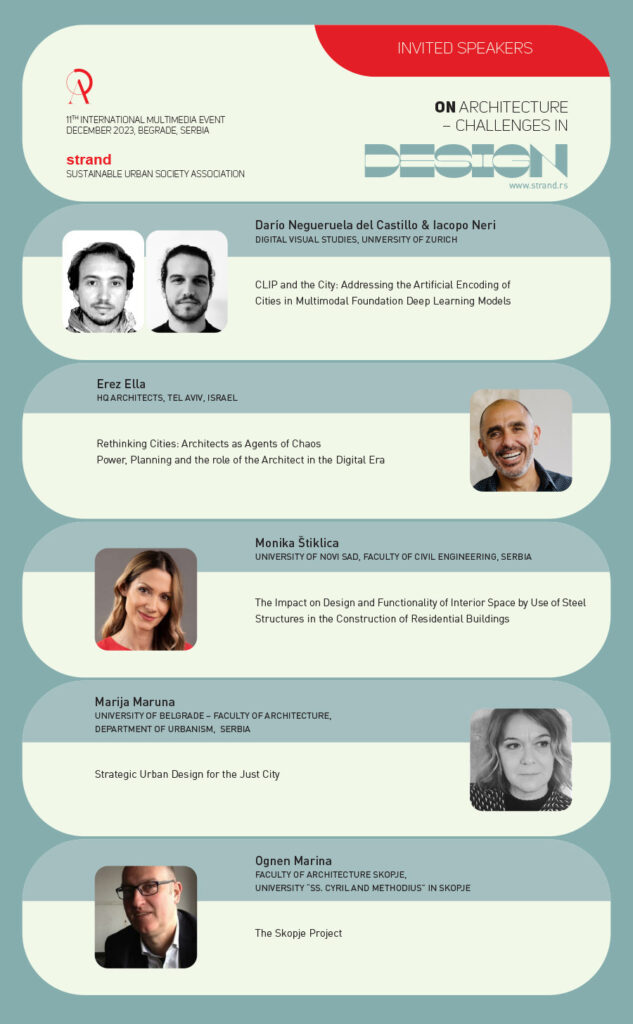
CONFERENCE Scientific Board
Professor Branislav Mitrović, Faculty of Architecture, University of Belgrade, Serbia
Professor Rachel Armstrong, School of Architecture, Planning and Landscape, Newcastle University, United Kingdom and KU Leuven, Belgium
Professor Vladan Đokić, Faculty of Architecture, University of Belgrade, Serbia
Professor Branko Kolarević, New Jersey Institute of Technology, Jersey, USA
Professor Ružica Bogdanović, University of Belgrade, Serbia
Professor Aleksandra Stupar, Faculty of Architecture, University of Belgrade, Serbia
Professor Figen Beyhan, Faculty of Architecture, Gazi University, Ankara, Turkey
Professor Pavlos Lefas, Department of Architecture, University of Patras, Greece
Professor Anastasios Tellios, School of Architecture, Aristotle University of Thessaloniki, Greece
Dr Ahmed Emam, Founder of ATO, Egypt
Dr Mitesh Dixit, Visiting Professor of Architecture Politecnico di Architecture DAD, Totino and the Founder of DOMAIN Office, USA
Dr Nora Lefa, Associate Professor, School of Fine Arts, University of Ioannina, Greece
Dr Venetia Tsakalidou, Associate Professor, School of Architecture, Aristotle University of Thessaloniki, Greece
Dr Aleksa Bijelovic, Senior Lecturer, School of Design and the Built Environment, Curtin University, Western Australia
Dr Tsaras Giannis-Nikos, Associate Professor, School of Architecture, Technical University of Crete, Greece
Dr Carmelo Zappulla, Faculty of Master in Advanced Architecture at IAAC, Institute for Advanced Architecture of Catalonia, Barcelona, Spain
Dr Anna Karagianni, Assistant Professor, School of Architecture, Technical University of Crete, Greece
Dr Renate Weissenböck, Graz University of Technology, Austria
Dr Denis Ambruš, Postdoctoral Researcher, Faculty of Civil Engineering, University of Rijeka, Croatia
Dr Christiane Wagner, University of São Paulo, Institute of Advanced Studies, USP Global Cities Program, Brazil
Dr Nataša Danilović Hristić, Senior Research Associate, IAUS, Belgrade, Serbia
Dr Senka Ibrišimbegović, Assistant Professor, Faculty of Architecture, University of Sarajevo, Federation BH
Dr Marija Mano Velevska, Associate Professor, Faculty of Architecture, Skopje, N. Macedonia
Dr Mateja Kurir, independent researcher, Ljubljana, Slovenia
EXHIBITION & AWARDS
Exhibition
Established in 2016, the MicroMacro awards are dedicated to the recognition of design solutions in innovative ways that successfully implement new standards in architecture and urban design and planning and encourage environmental sustainability.
Naming of the MicroMacro award refers to various scales of recognized projects and programs – from micro as furniture and object design, urban design, exhibition design, and interior architecture to macro as public art, urban planning, architecture, building information modeling and software architecture.
Who can enter?
The competition is open to individuals and organizations in the fields of architecture, urban planning, design, history, technology, art, photography, new media art and to all geographical locations.
Who can submit a nomination?
If you are an organization, an association, a not-for-profit or an individual you can nominate. You can self-nominate or nominate another organization.
Read 2023 Exhibition and Awards Guidelines.

Results and Jury Report
Sustainable Urban Society Association – STRAND announces the Evaluation Results on behalf of the Jury.
MicroMacro Award
in CATEGORY: ARCHITECTURE – DESIGN CHALLENGES IN MACRO AND MICRO SCALE
THE MEMORIAL CENTRE OF POGROM VICTIMS IN BAČKA
Maja Dragišić, Milan Božić, Milica Milosavljević, Divna Babović (Spring Studio), Serbia
Recognition
in CATEGORY: TECHNOLOGY AND ARCHITECTURE
ALTERATIONS: REDEFINING THE RELATIONSHIP BETWEEN NATURAL AND URBAN LANDSCAPE
Angelos Zigos, Greece
Recognition
in CATEGORY: REWORKING ARCHITECTURE/ CITY
ADAPTIVE BEAUTY: RECONSTRUCTION AND EXTENSION OF THE OLD STONE FAMILY HOUSE IN BAR
Milena Kordić, Serbia
Recognition
in CATEGORY: ART AND ARCHITECTURE
TRACING THE INTRICATE IN SCENE DESIGN: THE TEMPTATION TO BE HAPPY
Dejan Todorović, Serbia
Recognition
CATEGORY: NEW MEDIA AND NEW TOOLS IN DESIGN
BECOMING-WITH, ENCOUNTERS IN AN AUGMENTED GARDEN
Cenk Güzelis, Anna Pompermaier (./studio3, Me AndOther Me), Austria
EXHIBITION JURY
International Exhibition Jury Members – Stahl Stenslie (Norway), Snežana Zlatković (Serbia) and Branko Kolarevic (USA), President of the Jury.
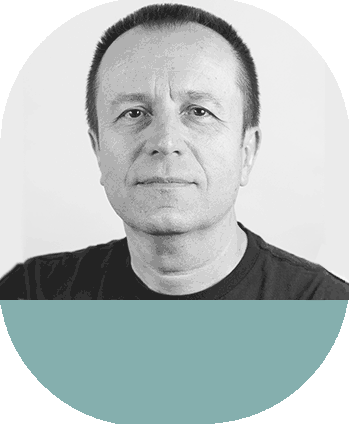
Branko Kolarevic
Branko Kolarevic is a professor and former dean of the Hillier College of Architecture and Design at NJIT in Newark. He has taught architecture at several universities in North America and Asia and has lectured worldwide on the use of digital technologies in design and production. He has authored, edited or co-edited several books, including “Mass Customization and Design Democratization” (with Jose Duarte), “Building Dynamics: Exploring Architecture of Change” (with Vera Parlac), “Manufacturing Material Effects” (with Kevin Klinger), “Performative Architecture” (with Ali Malkawi) and “Architecture in the Digital Age.” He was elected and served as president of several organizations: Association of Collegiate Schools of Architecture (ACSA), Canadian Architectural Certification Board (CACB), and Association for Computer Aided Design in Architecture (ACADIA). He is a recipient of the ACADIA Award for Innovative Research in 2007 and ACADIA Society Award of Excellence in 2015. He holds doctoral and master’s degrees in design from Harvard University and a diploma engineer in architecture degree from the University of Belgrade.
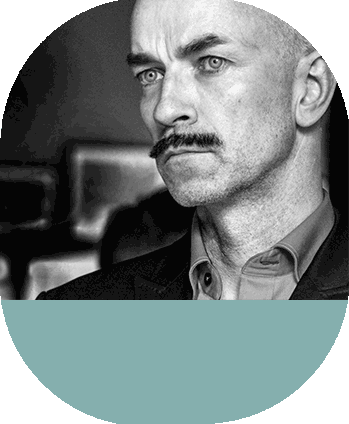
Stahl Stenslie
Artist, curator and researcher, specializing in experimental art, embodied experiences and disruptive technologies. Former professor in new media at The Academy of Media Arts, Cologne; The Oslo National Academy of The Arts; at Aalborg University (DK). Currently head of R&D at Arts for Young Audiences Norway. His research and practice focus on the art of the recently possible and disruptive design for emerging technologies. He has been exhibiting and lecturing at major international events (ISEA, DEAF, Ars Electronica, SIGGRAPH) and moderated symposiums like Ars Electronica (Next Sex), ArcArt and Oslo Lux. He is the editor of EE – Experimental Emerging Art magazine, has written numerous scientific articles and co-founded The Journal of Somaesthetics. His PhD on Touch and Technologies virtualtouch.wordpress.com.

Snežana Zlatković
Born in Belgrade, Yugoslavia (1988), graduated from the Faculty of Architecture in Belgrade (2012) where she is currently pursuing her doctoral studies and working as an assistant at the Department of Architecture (since 2018). She has worked as a designer in various architectural offices (since 2014). Her PhD research is focused on drawing as a methodological tool for reading the urban landscape. She founded the studio sz.dar (Drawing Architecture Research, 2017) with the aim to explore drawing through theoretical and artistic work. Her drawings were selected and published in Drawing Futures Book (The Bartlett School of Architecture, UCL, 2016) as well as awarded at Drawing of the Year (2016), RIBA Eye Line Drawing Competition (2017), STRAND (2016, 2018, 2020), INDEF (2020), Salon of Architecture (2020, 2021), My Cityscape Competition (2021), Collector’s Vision International Art Award (2021), Meta-City (2022), Call for Drawings (2023), etc. Representing Serbia at the Venice Architecture Biennale 2021, as a team member of eight architects(MuBGD). They were awarded the “Ranko Radović” Awards (2020, 2021), STRAND (2021).
PROGRAM
DAY 1
Tuesday, 5 December, 6.30 pm – 8 pm (CET) – Exhibition Opening and Award Ceremony at Gallery of Science and Technology of the Serbian Academy of Sciences and Arts, Belgrade, Serbia with representatives of MicroMacro Award Jury, Serbian Academy of Sciences and Arts as hosts and STRAND as organizers
DAY 2
Wednesday, 6 December, 6 pm – 8 pm (CET) – Conference Opening at Gallery of Science and Technology of the Serbian Academy of Sciences and Arts, Belgrade, Serbia
[serbian only] Conference Masterclass Presentation
RAZVOJ ARHITEKTONSKOG JEZIKA: OD PRIMARNIH DO APSTRAKTNE FORME
professor Branislav Mitrović (Serbia)
DAY 3
Thursday, 7 December, from 9 am (CET) – Conference Presentations at Serbian Academy of Sciences and Arts, first floor, room 3, Belgrade, Serbia
— 9 am – 11 am (CET) – Keynote and Invited Speakers Presentations
— 11.30 am – 1.30 pm (CET) – Session 1: Architecture – Design Challenges in Micro and Macro Scale
— 2 pm – 4 pm (CET) – Keynote and Invited Speakers Presentations
— 4.30 pm – 6.30 pm (CET) – Session 2-3: Technology and Architecture & Reworking Architecture/ City
DAY 4
Friday, 8 December, from 9 am (CET) – Conference Presentations and Closing at Rectorate of the University of Belgrade, first floor, room 8, Belgrade, Serbia
— 9 am – 11 am (CET) – Keynote and Invited Speakers Presentations
— 11.30 am – 1.30 pm (CET) – continued Keynote and Invited Speakers
— 2 pm – 3.15 pm (CET) – Session 4: Art and/ or Architecture
— 3.30 pm – 4.45 pm (CET) – Session 5: New Media and New Tools in Design
— 5 pm (CET) – Conference Closing
from 7.30 pm (CET) – Conference Dinner [OPTIONAL by registration]
The Organizers reserve the right to modify the Program.
Venues:
— Gallery of Science and Technology of the Serbian Academy of Sciences and Arts
Đure Jakšića 2, Belgrade, Serbia
— Serbian Academy of Sciences and Arts, first floor, room 3
Kneza Mihaila 35, Belgrade, Serbia
— Rectorate of the University of Belgrade, first floor, room 8
Studentski trg 1, Belgrade, Serbia (located in Kapetan Mišino zdanje)
Accomodation:
— Palace Hotel at Topličin Venac 23, Belgrade, Serbia.
Download full program for the 2023 International Conference and Exhibition “On Architecture – Challenges in Design”.
REGISTRATION & FEES
The Registration is closed.
Registration for latecomers will be made available upon request to info@strand.rs.
Information about the Registration fees:
EARLY Conference Registration (from 30 June to 30 July 2023)
— Author of 1 Paper (150 EUR)
— Doctoral Student Author of 1 Paper (100 EUR)
— Author of Conference Poster (100 EUR)
REGULAR Conference Registration (from 31 July to 20 September 2023)
— Author of 1 Paper (200 EUR)
— PhD Student Author of 1 Paper (120 EUR)
— Author of Conference Poster (120 EUR)
Social Activities
— City tour Belgrade between Ottomans and Austro-Hungarians (upon request from 30 EUR)
— Day tour Fruška Gora Monasteries and Sremski Karlovci (upon request from 60 EUR)
— Conference Dinner 25 EUR
Exhibition Registration (from 30 June to 20 September 2023)
— Registration fee is 50 EUR for 1 Poster
— Applicants can choose to exhibit their work on two or more Posters. For each additional Poster of the same work the fee is reduced.
ORGANIZATION
Partners
Supporting Partner
Serbian Academy of Sciences and Arts, Gallery of Science and Technology
University Partner
Rectorate of the University of Belgrade in Serbia
People
Conference and Exhibition Concept
Professor Ružica Bogdanović, Serbia
ruzica.bogdanovic@strand.rs
International Coordination
Professor Aleksandra Stupar, Serbia
aleksandra.stupar@strand.rs
Associate Professor Nora Lefa, Greece
nora.lefa@strand.rs
Organization and Realization
STRAND – Sustainable Urban Society Association, Serbia
Milan Maksimović, Project Officer
info@strand.rs

